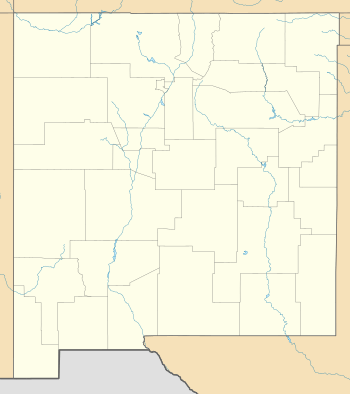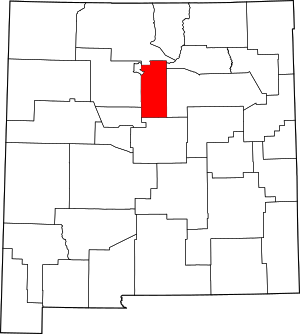Nambé Pueblo, New Mexico
Nambé Oweenge Pueblo (/ˈnɑːmbeɪ/; Tewa: Nambe Owingeh [nɑ̃̀ŋbèʔ ʔówîŋgè]) is a census-designated place (CDP) in Santa Fe County, New Mexico, United States and a federally recognized tribe of Native American Pueblo people. The Pueblo of Nambé has existed since the 14th century and is a member of the Eight Northern Pueblos.[2] It was a primary cultural, economic, and religious center at the time of the arrival of Spanish colonists in the very early 17th century. The community of Nambe is separate from the pueblo. Nambé was one of the Pueblos that organized and participated in the Pueblo Revolt of 1680, trying to expel the Spanish from the area.
Pueblo of Nambe | |
 The Kiva | |
  | |
| Nearest city | Santa Fe, New Mexico |
|---|---|
| Coordinates | 35°53′5″N 105°57′52″W |
| Area | 7.7 acres (3.1 ha) |
| Built | 1540 |
| NRHP reference No. | 74001208[1] |
| NMSRCP No. | 241 |
| Significant dates | |
| Added to NRHP | January 21, 1974 |
| Designated NMSRCP | March 13, 1972 |
Name
Nambé is the Spanish version of a similar-sounding Tewa word, which can be interpreted loosely as meaning "rounded earth." The word "pueblo" stems from the Spanish word for "village." Pueblo refers both to the Southwestern style architecture and the people themselves.[3]
Demographics
The 2010 census found that 1,818 people lived in the CDP,[4] while 568 people in the United States reported being exclusively Nambé[5] and 723 people reported being Nambé exclusively or in combination with another group.[6]
Language
The Nambé language is a dialect of the Tewa language,[3] also called Tano, which belongs to the Kiowa-Tanoan language family.[7]
History
Origin and early history
Scholars believe that all Pueblo peoples are descended from the Anasazi, possibly from the Mogollón, and other ancient peoples. In contemporary times, the people and their archaeological culture were referred to as Anasazi for historical purposes. The Navajo, who were not their descendants, called them by this term. Reflecting historic traditions, the term was used to mean "ancient enemies". Contemporary Puebloans do not want this term to be used. As the Ancestral Puebloans abandoned their canyon homeland due to social upheaval and climate change, they migrated to other areas. Eventually the Nambé emerged as a culture in their new homeland in present-day New Mexico.[3]
European contact
The Spanish conquistador Juan de Oñate arrived with armed forces in the area in 1598. He forced Nambé Pueblo, as was the case with other pueblos, to start paying him taxes with cotton, crops and labor. Catholic missionaries also came into the area, threatening native religious beliefs. They renamed pueblos with saints' names, and the first church was built in Nambé Pueblo in the early 1600s. The Spanish introduced new foods to the native communities, including peaches, peppers and wheat. In 1620 a royal decree assigned civil offices to each Pueblo.[3]
References
- "National Register Information System". National Register of Historic Places. National Park Service. July 9, 2010.
- "Nambe Pueblo". New Mexico, Land of Enchantment. New Mexico Tourism Department. Retrieved March 9, 2018.
- Barry Pritzker (2000). A Native American Encyclopedia: History, Culture, and Peoples. Oxford University Press. p. 49. ISBN 978-0-19-513897-9. Retrieved 23 November 2011.
- U.S. Census Bureau (2010). "NM - Nambé CDP". United States Census 2010. Retrieved March 9, 2018.
- Census 2010 American Indian and Alaska Native Summary File (AIANSF) - Sample Data, Pueblo of Nambe alone (H46)
- Census 2010 American Indian and Alaska Native Summary File (AIANSF) - Sample Data, Pueblo of Nambe alone or in any combination (H46) & (100-299) or (300, A01-Z99) or (400-999)
- "Tano/Tewa Indian Language". Native Languages of the Americas. Retrieved 22 April 2019.
External links
| Wikimedia Commons has media related to Nambé Pueblo, New Mexico. |
